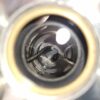Optical clocks are so accurate that it would take an estimated 20 billion years—longer than the age of the universe—to lose or gain a second. Now, researchers in the U.S. led by Jun Ye’s group at the National Institute of Standards and Technology and the University of Colorado have exploited the precision and accuracy of their optical clock and the unprecedented stability of their crystalline silicon optical cavity to tighten the constraints on any possible coupling between particles and fields in the standard model of physics and the so-far elusive components of dark matter.
The existence of dark matter is indirectly evident from gravitational effects at galactic and cosmological scales, but beyond that, little is known of its nature. One of the effects that falls out of theoretical analysis of dark matter coupling to particles in the standard model of physics is a resulting oscillation in fundamental constants. Ye and collaborators figured that if their world-class metrology equipment could not detect these oscillations, then this apparently null result would be useful confirmation that the strength of dark matter interactions with particles in the standard model of physics must be even lower than dictated by the constraints so far on record.
Clocking fundamental constant values
Previous attempts to pin down direct evidence of dark matter range from laboratory experiments to huge particle collider projects, such as those at the Large Hadron Collider (LHC). Many of these efforts have looked for interactions with, for instance, weakly interacting massive particles (WIMPs), which have masses similar to a silver atom in the range of 100 GeV, or axions—a hypothesized particle intended to explain elements of particle physics, and which might fit with theories of dark matter. However, Ye and his collaborators used their optical clock and cavity devices to home in on possible interactions between dark matter and particles at the lower end of the mass spectrum far below 1 eV, which is 500,000 times smaller than the mass of an electron at rest.
Optical clocks are a type of atomic clock. The first atomic clocks exploited hyperfine transitions in atoms of caesium 133—when the electrons in the caesium 133 atom flip spins, the resulting change in the energy of the atom’s state is emitted as electromagnetic radiation with a characteristic frequency in the microwave range. However, the transitions between electron orbitals in strontium atoms lead to energy changes with a much higher corresponding frequency in the optical range, and now that the technology has been developed to measure these transitions, even higher-accuracy time keeping is possible. What is more, the frequency of optical clocks is directly related to certain fundamental constants, providing a route to measuring the potential variations of these quantities with unprecedented accuracy.
Ye and collaborators used their optical clock to search for any variations in the fundamental constant α, the fine structure constant, which defines the strength of interactions between charged particles and photons. To this end, they compared the frequency of the strontium atoms used in the optical clock with their crystalline silicon cavity, a device used in lasers that allows electromagnetic waves to bounce between opposing reflecting surfaces and create a standing wave with a characteristic frequency determined by the cavity length. The frequency of both devices is defined in terms of both α and me (another fundamental constant that gives the mass of the electron) but with different dependences, so that the ratio between the two frequencies reveals any variations in the constant α.
“People have used atomic clocks at microwave frequencies to constrain the limits of dark matter coupling strengths, but this work would represent the first published results on the use of optical atomic clocks to provide constraints on dark matter,” says Ye.
As well as comparing the cavity frequency with the clock atoms, the researchers compared it with the frequency of a hydrogen maser—a microwave frequency standard that generates radiation based on transitions between different electronic and nuclear spin states in the hydrogen atom. Although the hydrogen maser does not provide time keeping as accurate as the strontium-based optical clock, the energy transitions it is based on lead to a different relation between frequency and the constants α and me, such that the ratio of its frequency with that of the crystalline silicon cavity provides a probe for variations in the value of me, as well. While oscillations in the value of α would indicate interactions between dark matter and electromagnetic fields, oscillations in me would reveal interactions with the electron mass.
The measured frequency ratios between the cavity and both the optical clock and the hydrogen maser also draw on another crucial advantage—the stability of the crystalline silicon cavity. “Most cavities are made of glass which is a disordered, amorphous solid that has a lot of dimensional drift and instability,” explains Colin Kennedy, a researcher in Ye’s group and first author in the report of these results, highlighting the advantage of using a cavity made up of one large single crystal of silicon. “This new generation of cavities are made from single crystals of silicon and are also kept at cryogenic temperatures, making them orders of magnitude more stable. This is the key advantage of our work.”
Closing in on dark matter
While (as expected) the researchers did not observe oscillations in the fundamental constants due to interactions with dark matter, their data narrowed the range of possible values the parameters of this interaction could have. For dark matter particles with masses in the range from 4.5 × 10−16 down to 1 × 10−19 eV, the possible strength of dark matter interactions defined by α is constrained by a further factor of up to five by these results, and those defined by me are constrained by as much as a factor of 100 for masses between 2 × 10−19 and 2 × 10−21 eV.
“The idea of using an optical cavity resonance frequency to compare against an atomic frequency was first proposed in an email exchange between myself and Prof. Victor Flambaum,” Ye tells phys.org, recalling their exchange around 2015. While Flambaum very quickly wrote a paper describing the basic ideas they discussed, Ye says that he “wanted to see the experimental results. And here we are.”
New theory on the origin of dark matter
More information:
Colin J. Kennedy et al. Precision metrology meets cosmology: Improved constraints on ultralight dark matter from atom-cavity frequency comparisons, Physical Review Letters, Accepted Manuscript. journals.aps.org/prl/accepted/ … 5e3b7a288ddee8f5ad29
On Arxiv: arxiv.org/abs/2008.08773
2020 Science X Network
Citation:
Precision metrology closes in on dark matter (2020, October 23)
retrieved 23 October 2020
from https://phys.org/news/2020-10-precision-metrology-dark.html
This document is subject to copyright. Apart from any fair dealing for the purpose of private study or research, no
part may be reproduced without the written permission. The content is provided for information purposes only.



